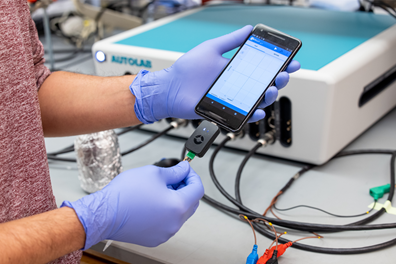
May 12, 2021
 Courtesy/Penn Medicine
Courtesy/Penn Medicine
RAPID is a low-cost COVID-19 diagnostic test developed by Penn Medicine researchers. Using screen-printed electrodes, the test can detect the coronavirus in human cells within four minutes with 90 percent accuracy, according to the results of a study using nasal swab and saliva samples from the Hospital of the University of Pennsylvania.
As the United States moves toward a broad summer reopening, ending more than a year of COVID-19 restrictions, researchers at Penn Medicine say they have created a diagnostic test that will aid long-term efforts to keep coronavirus transmission to a minimum.
Scientists behind the RAPID 1.0 test say their model uses electrical signals instead of the more common PCR tests, the hallmark of COVID-19 diagnostics during the peak of the pandemic.
Though PCR tests are highly accurate, they require large laboratories and skilled technicians to analyze results over a period that can take several hours or days. They're also costly to produce.
The test developed by Penn Medicine can render a positive or negative COVID-19 result within four minutes and at a rate of 90% accuracy, according to a paper published this week in Matter.
PCR tests have an accuracy rate in the 97% range, higher than the Penn Medicine test and other rapid tests that have increasingly hit the market over the past several months, but their cost and technical limitations in the long-term have driven the search for complementary testing methods.
The creators of the RAPID test at Penn devised a production method that uses electrodes made in large batches by a screen printer. The test detects the binding of the coronavirus spike protein to its receptor in the human body to trace electrical signals that indicate the difference between infected and healthy cells. These signals can be read using a desktop instrument or a smartphone.
"Prior to the pandemic, our lab was working on diagnostics for bacterial infections. But then, COVID-19 hit," said lead RAPID scientist César de la Fuente. "We felt a responsibility to use our expertise to help — and the diagnostic space was ripe for improvements. We feel strongly about the health inequities witnessed during the pandemic, with testing access and the vaccine rollout, for example. We believe inexpensive diagnostic tests like RAPID could help bridge some of those gaps.”
To assess the effectiveness of the RAPID 1.0 prototype, de la Fuente's team used both COVID-19 positive and negative clinical samples from the Hospital of the University of Pennsylvania. The samples included the highly contagious B.1.1.7 variant.
In blinded tests, researchers analyzed 139 nasal swab samples — 109 were COVID-19 positive and 30 were COVID-19 negative. They also analyzed 50 saliva samples.
Among the nasal swab samples, the RAPID test was 87.1% accurate. For the saliva samples, it was 90% accurate.
Researchers say the RAPID test is capable of detecting COVID-19 at extremely low concentrations, picking up a viral load that corresponds to the early stages of the virus two to three days after the onset of symptoms.
"Quick and reliable tests like RAPID allow for high-frequency testing, which can help identify asymptomatic individuals who, once they learn they are infected, will stay home and decrease spread," said Marcelo Der Torossian Torres, a postdoctoral researcher at Penn and first author of the study. "We envision this type of test being able to be used at high-populated locations such as schools, airports, stadiums, companies — or even in one's own home."
RAPID tests can be produced at a cost of just $4.67 each and can be made in the millions each week, de la Fuente's team said. The screen printer used at Penn Medicine to make the electrodes is able to produce 35,000 electrodes daily, or about 1.05 million per month, and uses an inexpensive filter paper material.
"Having low-cost tests which are quick and easy to read extends testing to not only people who can afford it, but to remote or disadvantaged areas," de la Fuente said.
The RAPID prototype was developed to address the need for COVID-19 testing, but the method can also be used to detect other viruses such as the flu and sexually transmitted diseases.